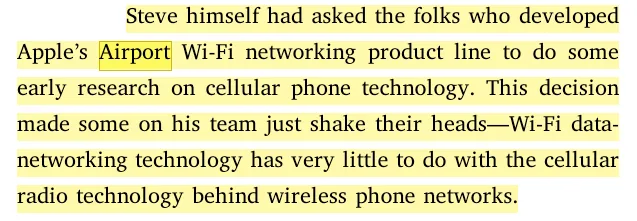Steve Jobs and Wi-Fi
At Macworld NY in 1999, Steve Jobs, then the iCEO of Apple, introduced the first iBook. With bright colorful polycarbonate cases and a convenient tote handle, the iBook was the final piece of the Four Quadrant strategy that brought Apple back from the brink of insolvency. It was also the first portable computer to include wireless connectivity built-in. Paired with the original AirPort access point it was the first wireless networking system for consumers, and a huge hit with the crowd at the show, and it ushered in the age of Wi-Fi.
Communication and Personal Computing
Steve’s interest in networking personal computers goes back to the Apple I, in Isaacson’s biography we see him asking Woz about the possibility very early on:

Steve Jobs (2013)
Seeing computers as more than just calculators, but tools for personal expression and communication was at the core of the revolution. When the Apple team managed to negotiate their way into the Xerox PARC, they saw the Alto, the first truly networked personal computer. Wowed by the graphical user interface which was the focus of Lisa and Macintosh development, the networking abilities of these new machines were glossed over until AppleTalk was released in 1985.

Steve Jobs (2013)
From the beginning of Apple, Steve saw that communications capabilities were going to be key to making the personal computer successful. Building Blue Boxes with Woz provided the practical experience and some of the funding that made some of Apple’s first products possible and clearly influenced his thinking around the power of networking.
The Fever Dream of an Open Wireless Internet
When Wi-Fi first started to become popular, after the iBook was released and the feature started to become standard in the mobile computing world, many people started to wonder if it was going to supplant the very slow cellular data networks, then rated in Kbits per seconds and priced much higher than current offerings. Startups, community groups and forward thinking municipalities all started efforts to build out wireless networks on top of Wi-Fi, seen as an inexpensive, higher performance alternative to the then very expensive Cellular data networks.
Community Wi-Fi was seen as the extension of the Personal Computing ethos into communications: the ability to build the network ourselves out of off the shelf components, providing coverage anywhere and everywhere that a back-haul connection—even just a dial-up line—could be established without having to ask the permission of the phone company. Just like the PC revolution before it, users lead the way: I personally purchased an extra AirPort Access Point to go along with my new iBook and brought it into the office. After some tense negotiation with the IT staff I was able to install the funny looking device on a cubicle wall, wire it into the office network and enjoy wireless network connectivity everywhere in the building.
It seemed natural to many of us that we would simply keep doing this; extending the network to our homes, coffee shops, creating a network of networks, mirroring the growth and open nature of the Internet itself. Which was becoming a more and more important tool in our lives, with the multimedia tech boom of the early 90’s making way for the .com bubble and now web 2.0 and beyond. Explosive growth of the Internet was the new norm, and we were busy building the systems and businesses to thrive in this new technological niche.
Enter the iPhone
When the iPhone was released, it was famously introduced as “a Phone, a Music Player and an Internet Communicator” which fit in your pocket. These three features packed into a piece of hardware like nothing anyone had ever seen, including a new and remarkable user interface driven by the touch of a finger. The iPhone eclipsed the nascent smartphone market and defined an entire new category of computing devices that most of us now carry with us nearly every moment of our lives.
Of course the iPhone had to have Wi-Fi, but it also had a Cellular Data radio which supported the Phone functionality as well as Internet access when away from home or the office. Steve didn’t want to play nicely with the Cellular carriers, Walt Mossberg recalls Steve’s interest in using Wi-Fi to replace cellular:
The first iPhone had a lousy, sluggish, cellular-data network, but it also had a much faster data option: Wi-Fi. It even had a feature (still present, but much less touted) that popped up a list of nearby Wi-Fi networks on the screen, so you could always find one in range.
But, he once told me, there was a big problem with that technique, one that he wanted to fix: Most of the Wi-Fi networks that popped up on his screen couldn’t be used, because they were secured with passwords. Jobs said he understood the need for security, but he was determined to figure out a way to make free, safe, Wi-Fi sharing from homes and small local businesses not only possible, but common.
How to Become a Bozo
Steve’s deep interest in this really shows when you look at the few mentions that the AirPort team gets in his biographies, the original introduction is remembered as a high point, but during the development of the iPhone they didn’t give him the answers he was looking for, and the recollections are tainted with typical Jobsian scorn:

Becoming Steve Jobs (2015)

Becoming Steve Jobs (2015)
Since the release of the iPhone many, many, many, many, articles have appeared with tantalizing details of Steve’s vision of a shared Wi-Fi network which could eventually supplant the Cellular networks we rely on today. Of course we don’t have that network today, though there are still people working on it here and there, home and office networking has fallen far behind what’s possible.
Grounded
Sadly, Apple as a company seems to have disengaged from the home networking market. While the AirPort product line is still sold, the latest firmware has some issues, and the prospects for an update seem to be slim. New players such as Eero are scrambling to enter the void left behind, and Google is throwing it’s weight behind not only city wide wireless networks but a new mysterious Wi-Fi Access Point. Open Source efforts to improve Wi-Fi quality and reliability move forward slowly but the dream of a single shared network, accessible anywhere, built by it’s users, and offering better connectivity, performance and reliability at a lower cost than the existing cellular networks seems to be, for the time being, just out of reach.
Postscript
A couple of people who know a lot more about this, since they were at Apple when Steve made his request to build a shared Wi-Fi network objected that the source material didn’t reflect what actually happened.
From what I can tell the animus in these quotes come from the Issiacson biography, which was based on a lot of interview time with Steve. We all know how well he could bend reality in both directions, so this seems to have been his view of things through the filter of the intervening years.
History is prismatic in nature, but what’s clear to me is that everyone who has tried to build a shared Wi-Fi network at Apple (and I can think of more than one or two people) has failed. Steve wanted it, and he’s not known for taking ‘no’ for an answer gracefully.
